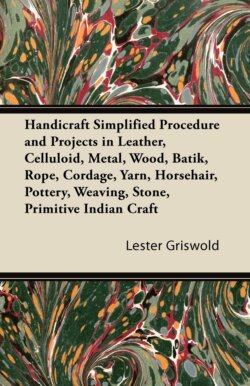Читать книгу Handicraft Simplified Procedure and Projects in Leather, Celluloid, Metal, Wood, Batik, Rope, Cordage, Yarn, Horsehair, Pottery, Weaving, Stone, Primitive Indian Craft - Lester Griswold - Страница 55
На сайте Литреса книга снята с продажи.
Lacing Procedure
ОглавлениеStart at the middle point of each gusset, parts 5 and 6 and lace the edges to part 4. Gusset number 5, with center point marked O should be laced to the purse, part 4, starting at point O. Gusset No. 6 with center point marked T should be laced to the part 4 starting at the point T. See Sketch 12 which shows the method of joining gusset 6 to purse, part 4. Note the lacing thong is passed through the two center points of the gusset 6 and each end of the lacing is carried forward, using the whip stitch, see Sketch B, page 69. One end of the lacing thongs moves to the right while the other moves to the left. Gusset 5 is attached to part 4 in a similar manner, page 75.
Lace the parts 7 and 8 to the upper edge of gusset 6 as indicated by Sketch 15. Start the lacing as indicated by Sketch 11. End the lacing as shown in Sketch 17 to 20.
Lace the upper edge of gusset 5 as indicated in Sketch 14. Two short lacings may be used and the ends left protruding to serve as a finger hold opposite the tab T, Sketch 3. These two extensions are a convenience in opening the purse.
End the lacing at the gusset tip as shown in Sketch No. 17 to 20. Pass the lacing through the last hole in the gusset twice as indicated in Sketch 18 and carry the end under three or four loops, as shown in Sketch 20. Tighten the lacing before cutting off the end.
Small Hand Purses and Vanities may be constructed with a folded pocket gusset as used in the purse illustrated on page 18, No. 4. Unless a thin piece is available for this pocket it is necessary to skive the sections along both the inside and outside folds. This may be done with the skiving knife if the piece is bent over the straight edge of the skiving glass or stone, but great care must be taken to avoid cutting through. A safer method of thinning the section to be folded is to apply sand paper stretched over a small block of wood. The gusset pocket, No. 2, page 24, has been stitched along the fold to permit the insertion of a small straight pocket. A soft pliable leather, preferably the thin sections of steer hide, is most satisfactory for this type of purse. Wide whip lacing is recommended as the wider spacing of the holes permits punching on either side of the two folds as shown in the illustration, page 24. If a hole is punched on the fold it is almost sure to tear out. A variation of a folded pocket is used in the coin purse illustrated in Fig. 5. This is cut with a flare at the top and fits the outside at the bottom so that the fold slopes to a point just inside the lacing holes.
Fig. 5
